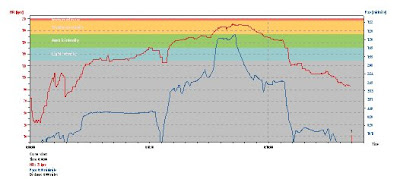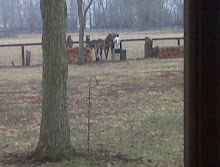
Tuesday, February 24, 2009
Ice Storm 2009

Tuesday, February 17, 2009
Training and Conditioning: Humans vs Horses
Friday, February 13, 2009
Thoroughbred exercising with EPM

Thursday, February 12, 2009
Stakes-level horse during a 6 furlong breeze:
 Legend:
Legend:Monday, February 9, 2009
Michael Dickinson, creator of Tapeta
Bleeding (EIPH), Lasix and synthetics
Saturday, February 7, 2009
Training to avoid bucked shins

Friday, February 6, 2009
Interval Training the Thoroughbred
Thursday, February 5, 2009
Rune Haugen, using science to train winning thoroughbreds
Total turn-around
- At “Stall Nor” one top-bred horse after the other broke down and never even made it to the races. The owners were obviously frustrated, and contacted Sæterdal. He transferred human training principles to the horses at “Stall Nor”. He controlled the horses training doses by using heart rate monitors. Within months, the negative trend had turned. The injury-rate fell drastically and the horses started to win races, says Haugen, not mentioning his own important role in the turning process. He was hired as the new trainer at the stable, thus responsible for putting Sæterdals training principles into practice.
- Heart rate monitors, lactate- and muscle enzyme-tests are the aids I use to control my horses work-out routines, Rune Haugen explains.
- A heart rate monitor measures the beating of the heart. I use the information from the monitor to determine how a horse responds to training. I combine this with blood tests. If a horse works out at a certain pulse level, I can measure the lactate level in the blood afterwards. The link between lactate level and heart rate gives me essential information about a horse’s capacity, training development and possible sickness, he says eagerly.
- Why is the heart rate monitor so essential in your training routine?
- Because by using the HR monitor I know the exact status of my horses’ physical shape at any given time. The race season for thoroughbred horses is short. This means it is extremely important to have the horses in top shape in just the right time.
Once he has started talking about the advantages of pulse-based training, he can’t seem to run out of arguments:
Training consultant for the Olympic team
- I also have to point out the importance of being able to reproduce a certain training routine. I’ve succeeded with several racehorses in the past years. But what if I had these successful horses, but subsequently didn’t have a clue how hard I actually trained them? How would I be able to learn from what I’d done? , Haugen asks rhetorically.
Is it hard to learn how to use a heart rate monitor on horses?
- The training jockeys at the stable are taught to make the horses stay at a specific pulse during a workout. I decide the pulse level for each horse in advance, and it’s very important that my employees follow my directions as precise as possible. To inspire them to do so, I have introduced “Watch of the Month”, meaning the jockey that has stayed closest to the right heart rate during a month is rewarded, Rune Haugen explains. This man certainly seems to be in control of every detail of his horses` routines.
- How would it be, do you think, to go back to training horses without using the heart rate monitor-system?
Wednesday, February 4, 2009
Heart Rate Training Zones explained
This is the pace at which the horse is still able to use lactic acid for energy, which delays the onset of fatigue during a race. Targeting gallops towards this zone will improve cruising speed in a race. Only accompished by a 2:00 lick in ELITE horses, others will need to slow down.
The AEROBIC zone (70-80% of max HR)
This intensity best develops lung function and improves the horse's ability to use oxygen to fuel movement. Exercise at this pace actually allows for the creation of new blood capillaries which aid in performance. Happens a lot during the 'legging up' phase of getting a horse ready for the races, but often neglected when racing commences.
The RECOVERY zone (60-70% of max HR)
Here is the optimal pace to train in which any lactic acid is flushed away, and the recovery processes are enhanced. Best used after a breeze for 60-90 seconds before exiting the track. Many jogs, especially indoors, are just a tad to slow to accomplish optimal recovery.
Tuesday, February 3, 2009
Why Heart Rate Zone training increases thoroughbred stamina
 Horses are so very unique to humans when it comes to exercise physiology.
Horses are so very unique to humans when it comes to exercise physiology. Monday, February 2, 2009
ThoroEdge Equine Performance
Sunday, February 1, 2009
Curlin at Lane's End




